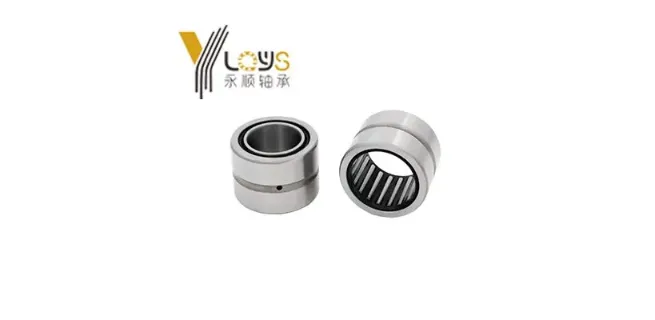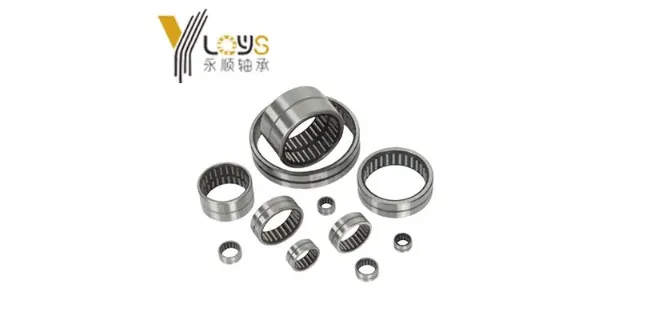كيفية الاختيار بين الحلقة الداخلية ومحامل الإبرة الخالية من الحلقة
2025-10-27

مقدمة
محامل الأسطوانة الإبرة هي أجزاء صغيرة ولكن قوية في الآلات. فهي تحمل حمولات ثقيلة في مساحات صغيرة، مما يجعلها شائعة لدى المهندسين الذين يعملون على الأتمتة أو الروبوتات أو المعدات الصناعية. اختيار النوع الصحيح، الحلقة الداخلية أو بدون حلقة، يمكن أن تقرر ما إذا كانت الآلة تعمل بسلاسة أو تفشل.
ما هي محامل الأسطوانة الإبرة؟
محامل الأسطوانة الإبرة استخدام طولان طويلة ونحيلة للتعامل مع الأحمال الشعاعية الكبيرة. يتناسب شكلها النحيل في أماكن ضيقة، مثل صناديق التروس أو أذراع الروبوت. الأطوال ، والتي غالبا ما تسمى الإبر ، طويلة مقارنة بعرضها ، مما يعطي قوة دون أن تستغرق الكثير من المساحة.
أهمية اختيار نوع المحامل الصحيح
الحصول على المحامل الصحيحة يعزز الكفاءة، ويقلل الصيانة، ويحافظ على تشغيل الآلات لفترة أطول. قد تتلاشى المحامل الخاطئة بسرعة أو تفسد المحافظة. في مجالات مثل الأتمتة أو المعدات الثقيلة ، حيث يكلف وقت التوقف ثروة ، يوفر الاختيار الصحيح المتاعب.
استكشاف النوعين الرئيسيين
محامل الإبرة مع حلقة داخلية
محامل الإبرة الداخلية تأتي مع مسار سباق داخلي منفصل ينزلق على العمود. هذا الإعداد يجعل التثبيت سهلًا لأن العمود لا يحتاج إلى أن يكون صلبًا أو ناعمًا تمامًا. إنها موثوقة ، وهو أمر رائع عندما لا تكون إعداد العمود من الدرجة الأولى. بالإضافة إلى ذلك ، فإنها تؤدي بشكل ثابت في ظروف مختلفة وسهلة وضعها. لكنها أقل شوية ، والتي يمكن أن تكون مزعجة في المساحات الضيقة حقاً.
محامل الإبرة بدون حلقة (بدون حلقة داخلية)
محامل الإبرة بدون حلقة تخلص من الحلقة الداخلية ، باستخدام العمود نفسه كمسار سباق. هذا يجعلها خفيفة ومدمجة ، مثالية للأنظمة الضيقة. إليك الصيد: يجب أن يكون العمود جامدًا وسلسًا للغاية لتأخذ الحمل. هذه المحامل تناسب إعدادات عالية الدقة، وتقدم تصميم رقيق عندما يحسب كل قطعة من المساحة. إنها مثل السيارة الرياضية من المحامل ، أنيقة ولكن مختارة حول الظروف.
مقارنة الحلقة الداخلية مقابل محامل الإبرة بدون حلقة
الاختلافات الهيكلية والأبعاد
التعليقات على: محامل كريات الأخدود العميق: المكونات والتطبيقات والفوائد
قدرة التحميل والأداء
كلا النوعين يديران الأحمال الشعاعية الثقيلة بشكل جيد. ومع ذلك ، تميل محامل الحلقة الداخلية إلى أن تكون أكثر استقرارًا. ينتشر الحلقة الداخلية الإجهاد بشكل متساو ، مما يقلل من التآكل عندما تتحول الأحمال أو تصبح ثقيلة. يمكن للمحامل بدون حلقة مواكبة ، ولكن فقط مع عمود من الدرجة العليا. إذا كان العمود ضعيفًا ، فأنت تبحث عن ارتداء أسرع أو حتى تعطل. إنه مثل الاختيار بين حذاء العمل الصعب وحذاء الجري الخفيف ، يعتمد ذلك على الوظيفة.
متطلبات العمود وصلابة السطح
محامل خاتم تحتاج إلى عمود أرضي دقيق ومصلب ، وعادة ما يكون صلابة 58 64 HRC. إذا كان ناعمًا ، فقد ينحني العمود تحت الضغط. محامل الحلقة الداخلية ليست مضطربة. إنها تعمل بشكل جيد مع عمود ناعم أو أقل مثالية. وهذا يجعلها أكثر أماناً في الإعدادات التي لا تعد معالجة العمود الفاخرة خياراً. الذهاب بدون حلقة لتوفير المساحة مغري، ولكن عمود رخيص يسبب مشاكل.
اعتبارات الصيانة والاستبدال
محامل الحلقة الداخلية هي رياح لتحل محلها. يمكنك تبادل الخاتم الداخلي دون الكثير من المتاعب. ومع ذلك ، تعتمد المحامل بدون حلقة على حالة العمود. إذا ارتدى العمود أو تضرر ، فإن إصلاحه مهمة أكبر. قد تبدو المحامل بدون حلقة أرخص في البداية لأنها أبسط من حيث التكلفة. ولكن التكاليف على المدى الطويل تعتمد على جودة العمود واحتياجات الصيانة.

سيناريوهات التطبيق
متى تستخدم محامل الإبرة الداخلية
محامل الحلقة الداخلية تعمل بشكل رائع عندما لا يكون العمود جامدًا أو ناعمًا للغاية. ستراهم في صناديق التروس الثقيلة أو المضخات الهيدروليكية أو آلات المصانع العامة. هذه الإعدادات تقدر الموثوقية على الحجم الصغير. على سبيل المثال ، قد يستخدم ناقل في مصنع محامل حلقة داخلية للتعامل مع الأحمال الكبيرة دون الحاجة إلى عمود مثالي.
متى تستخدم محامل الإبرة بدون حلقة
محامل خاتم رائعة للمعدات المدمجة عالية الدقة. فكر في مفاصل الروبوت، شرائح الأتمتة، أو المحركات الصغيرة. هذه تحتاج إلى تسامحات ضيقة وأحماث متصلبة ، لكنك تحصل على إعداد أصغر وأخفف. في نظام الحركة الخطية لآلة CNC ، تحافظ المحامل بدون حلقة على الأشياء رقيقة وفعالة. فقط تحقق مرتين من العمود حتى التدخين.
كيفية اختيار النوع المناسب لتطبيقك
خطوة بخطوة دليل الاختيار
اختيار المحامل الصحيحة تبدأ بمعرفة الإعداد الخاص بك. إليك دليل بسيط:
-
تحقق من المساحة: إذا كانت الغرفة ضيقة ، فاز المحامل بدون حلقة بحجمها الصغير.
-
انظر إلى الحمل والسرعةحمولات كبيرة ومتغيرة؟ محامل الحلقة الداخلية أكثر استقرارًا.
-
تحقق من العمود: إذا لم يكن جامدًا أو ناعمًا للغاية ، فالتزم بمحامل الحلقة الداخلية.
-
فكر في التشحيمكلاهما يحتاجون إلى تزييت جيد ، ولكن تلك التي لا خاتم تعاني أكثر إذا كانت تفتقر.
-
خطة لطول العمروزن الصيانة والعمر لموازنة التكاليف المبكرة مع الوفورات المستقبلية. في بعض الأحيان ، يساعد رسم الإعداد أو إجراء فحص سريع للحمل. إنها ليست مثيرة ، لكنها تتجنب الأخطاء المكلفة.
الأخطاء الشائعة لتجنبها
أوبس كبير هو استخدام محامل بدون حلقة على عمود ناعم ، إنه مثل قيادة سيارة سباق على طريق الحصى. فكرة سيئة وهناك خطأ آخر يتمثل في تجاهل مشاكل المواءمة أو التسامح. كلا المحامل تحتاج إلى الإعداد المناسب، ولكن تلك بدون حلقة هي أكثر اختيارا. قطع الزوايا على جودة العمود أو التشحيم لتوفير النقود هو فخ. إنه مثل تخطي تغييرات زيت السيارة ، ستدفع في وقت لاحق.
أين العثور على المحامل المناسبة
الهندسة الدقيقة ومراقبة الجودة
يونغهيشون، صانع المحامل ، يلتزم بمعايير عالية في عملهم. تمر محامل الإبرة الخاصة بهم بفحوصات صعبة لضمان أنها تتحمل في الوظائف الشاقة. الدقة مهمة، خاصة في الروبوتات أو الآلات الثقيلة، حيث يمكن أن يسبب عيب صغير مشاكل كبيرة.
تصميم مخصص ودعم تقني
يوفر Yongheshun خيارات مخصصة للروبوتات والأتمتة والصناعات الثقيلة. يقدم فريقهم مساعدة خبيرة لاختيار المحامل المناسبة ، سواء كانت قياسية أو خاصة. هذه مساعدة كبيرة لمصنعي الأصول الأصلية مع احتياجات فريدة.
التعليقات على: المحامل الدقيقة: دفع تطور الروبوتات
مقارنة مع الأسماء الكبيرة مثل كويو أو NSK ، تقدم Yongheshun أسعار أفضل وتسليم أسرع. إنتاجها المرن يناسب مصنعي المصانع الأصلية الذين يحتاجون إلى تصاميم محددة أو إصلاحات سريعة.
استنتاج
التعليقات على: محامل عالية الدقة تعزز التصنيع الذكي
الأسئلة الشائعة
س: ما هو الفرق الرئيسي بين الحلقة الداخلية ومحامل الإبرة بدون حلقة؟
ج: تحتوي محامل الحلقة الداخلية على مسار سباق داخلي منفصل ، مما يجعلها أكثر حجماً ولكنها أسهل الاستخدام على العمود الخام. تستخدم تلك التي لا حلقة العمود كمسار سباق ، وتوفير المساحة ولكن تحتاج إلى عمود صلب وسلس.
س: هل يمكن لمحامل الإبرة بدون حلقة التعامل مع نفس الأحمال مثل الحلقة الداخلية؟
ج: نعم ، إذا كان العمود جامد بشكل صحيح وسلس. ومع ذلك ، عادة ما تكون محامل الحلقة الداخلية أكثر استقرارًا مع تغيير الأحمال.
س: هل المحامل بدون حلقة أرخص من المحامل الداخلية؟
ج: يمكن أن تكون أرخص لأنها أبسط ، ولكن التكاليف تعتمد على إعداد العمود والصيانة.
س: أين هي محامل الإبرة الداخلية الداخلية الأكثر شيوعا؟
ج: ستجدهم في صناديق التروس الثقيلة والمضخات الهيدروليكية وآلات المصنع حيث لا تكون سلاسة العمود مهمة.
س: كيف يمكن Yongheshun المساعدة في اختيار المحامل؟
ج: تقدم Yongheshun تصاميم مخصصة ودعم خبير ، مما يساعد المهندسين على اختيار أو بناء محامل للروبوتات أو الأتمتة أو الصناعات الثقيلة.







